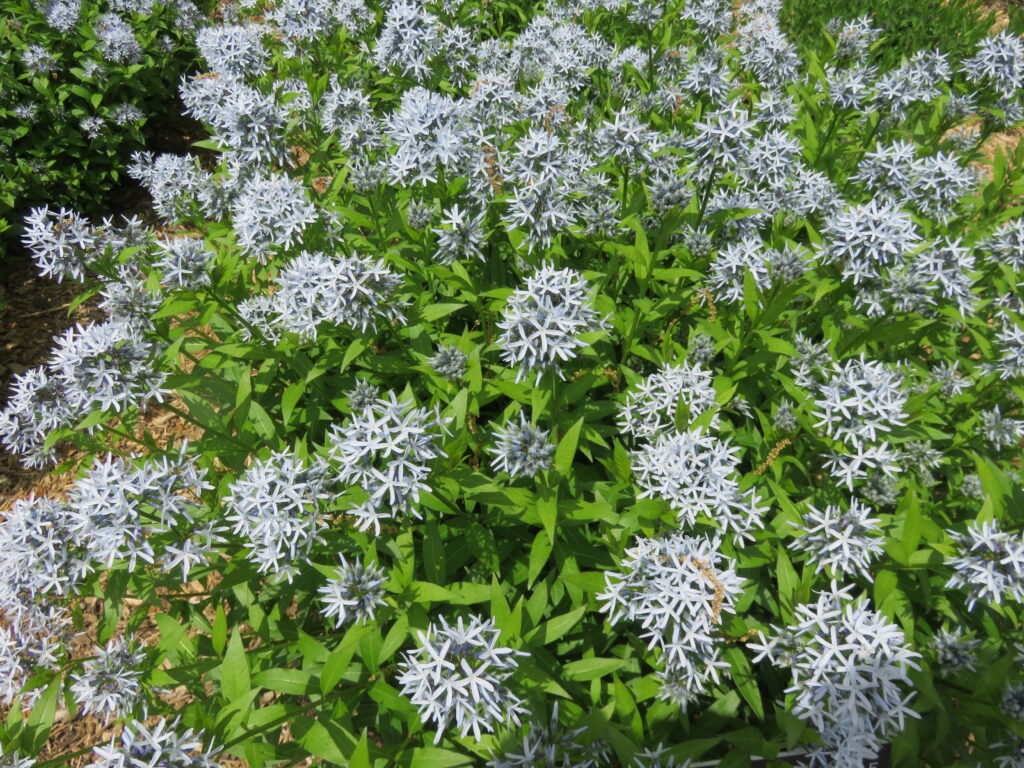
MT. Cuba Center is located near Hockessin Delaware, near Wilmington (USDA hardiness zone 7a.). It has recently published a new trial report on bluestars (Amsonia spp.) for the mid-Atlantic region. BlueStars are a genus of popular, long-lived herbaceous perennials. Most are native to the U.S. and Mexico in addition to one Asian species (A. elliptica) and (A. orientalis) in Greece and Turkey.
Mt. Cuba Center conducted over 10 years that evaluated several varieties, cultivars, and hybrids of three U.S. native species – A. ciliata, A. hubrichtii, and A. tabernaemontana. The trial focused on garden performance and ornamental qualities. It evaluated 20 different Amsonia varieties.
Amsonia species and cultivars vary in overall size and ornamental qualities such as foliage texture and bloom time, but all provide multiple seasons of ornamental interest. Sprays of blue flowers arrive in mid-spring followed by blemish-free summer foliage. Many varieties close the year with outstanding gold or orange fall color, especially when grown in full sun.
Cold hardiness will vary with species. Most bluestars are hardy in USDA hardiness zones 3-11. In harsh northerly areas, bluestars may be overwintered by covering them in a heavy frost blanket, or overwinter container plants in an unheated garage that stays just above freezing.
The Amsonia trial was grown in part-to-full sun in “average” soil, best described as clay-loam with a pH near 6.5. Throughout the trial, plants were given minimal care. Supplemental water was provided only during the first year after planting to encourage establishment.
BlueStars support early-season pollinators including native bees and hummingbirds and are the host plant for several species of butterflies and moths. Amsonias are botanical members of the Apocynaceae family, which includes milkweed (Asclepias); plant stems produce a milky sap that discourages browsing by deer and other mammals.
Most BlueStar varieties grow about 2-3 feet tall, and 2-3 feet wide. small, tidy, shrub-like clumps. Leaves are 3-4 inches, narrow and lance-shaped, with a pronounced mid-rib. Species size will depend on the variety grown and garden conditions.

Garden notes: Amsonia species prefer from full sun to part shade and a moist soil with a pH between 6.2-7.0 but adapt to most soils. They do not like prolonged dry conditions but once established. BlueStar plants can handle brief periods of drought. BlueStars thrive in a hot and humid climate.
Bluestar requires very little maintenance. Bloom clusters can get floppy when heavy with flowers and the seed pods that follow. To prevent this, either stake them with a hoop or trim them back by one third after flowering. Trimming will mean losing the attractive seed pods.
BlueStar can be grown from seeds harvested when the pods dry. You can start seeds in the fall or overwinter them in a cold frame or protected area, then transplant in the spring. Simply cover them lightly with soil and keep the soil moist until plants germinate.
Minor chlorosis and rust symptoms occur in high pH above 7.0. Otherwise, BlueStar plants are virtually problem free, and pests or diseases regularly bother them.
In late winter or early spring, cutback (cleanup) the previous year’s foliage. BlueStar stems are hollow, leaving 12 –18 inches of stem and provide a habitat for native bees.
Diseases were infrequently observed in this trial, and aside from the plants were virtually pest and disease free. BlueStar may be started from seed or purchase plants from nurseries and garden centers.


 Posted in
Posted in 
